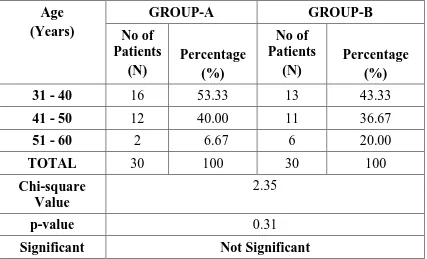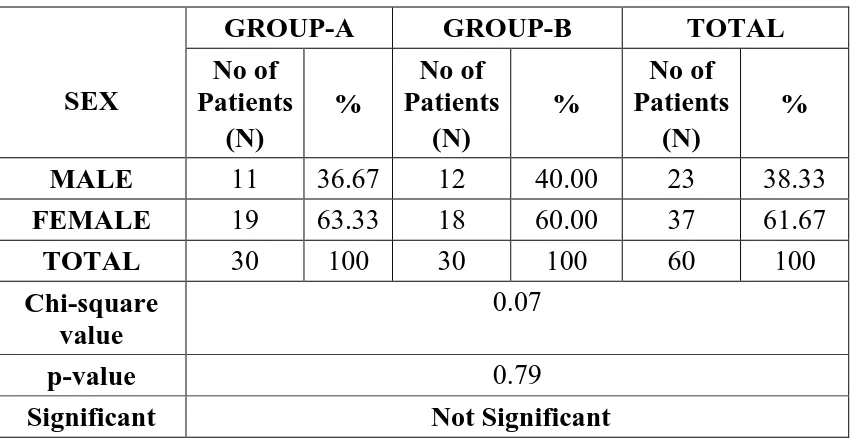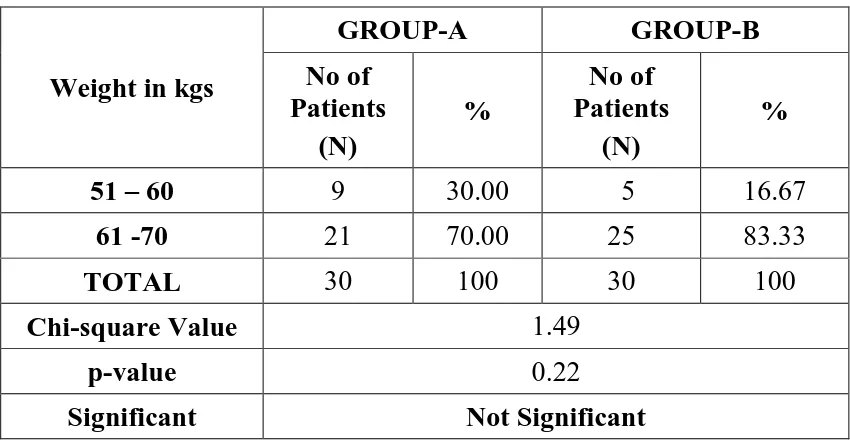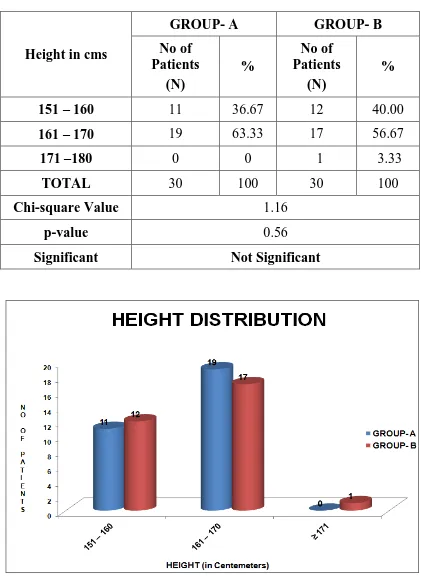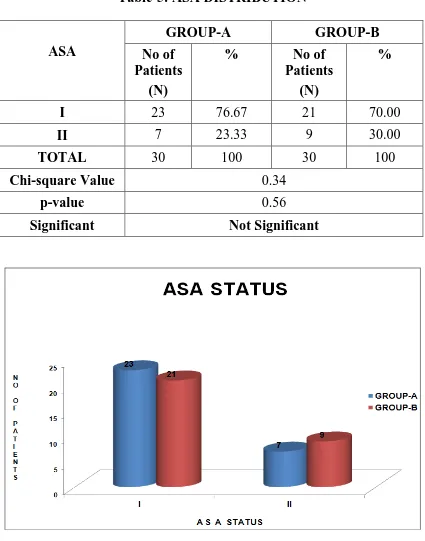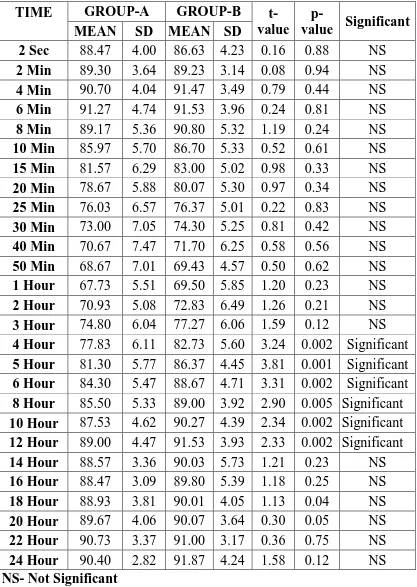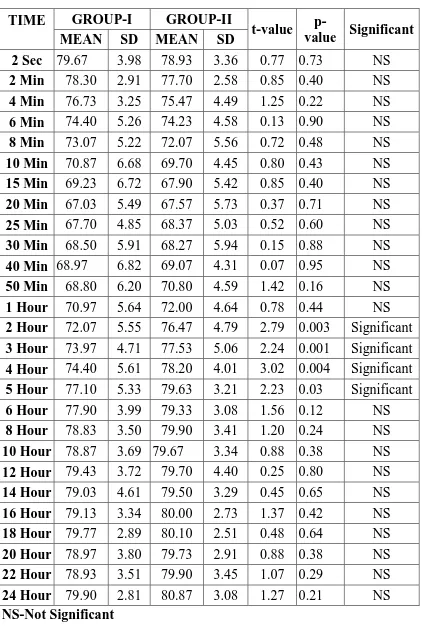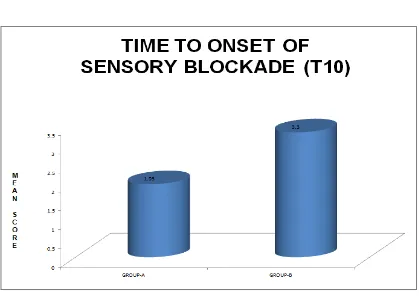A
PROSPECTIVE RANDOMIZED CONTROLLED
STUDY COMPARING ANAESTHETIC EFFICACY OF
INTRATHECAL NALBUPHINE HYDROCHLORIDE
WITH BUPIVACAINE AND BUPIVACAINE ALONE
FOR INFRAUMBILICAL SURGERIES
Dissertation submitted in partial fulfillment of the regulations for the award of the degree of
M.D ANESTHESIOLOGY
BRANCH-X
Of
TAMIL NADU Dr. M.G.R. MEDICAL UNIVERSITY
CHENNAI, TAMILNADU
ESIC- MEDICAL COLLEGE & POSTGRADUATE
INSTITUTE OF MEDICAL SCIENCE AND RESEARCH,
KK NAGAR, CHENNAI-78.
This is to certify that this dissertation titled "A PROSPECTIVE
RANDOMIZED CONTROLLED STUDY COMPARING
ANAESTHETIC EFFICACY OF INTRATHECAL NALBUPHINE
HYDROCHLORIDE WITH BUPIVACAINE AND BUPIVACAINE
ALONE FOR INFRAUMBILICAL SURGERIES" submitted
by Dr.Karthick.K, appearing for M.D Degree Branch–X
ANAESTHESIOLOGY examination in April 2017 is a bonafide record of work done by him under my direct guidance and supervision in partial fulfillment of the regulations of Tamil Nadu Dr. M.G.R Medical University, Chennai. I forward this to the Tamil Nadu Dr. M.G.R Medical University, Chennai Tamil Nadu, India.
DEAN
Dr. SRIKUMARI DAMODARAM,
M.S., M.Ch (SGE), M.A.M.S.,
DATE: F.A.C.S., F.I.C.S., F.M.M.C
PLACE: K.K. Nagar ESIC Medical College and PGIMSR
This is to certify that the dissertation entitled "A PROSPECTIVE
RANDOMIZED CONTROLLED STUDY COMPARING
ANAESTHETIC EFFICACY OF INTRATHECAL NALBUPHINE
HYDROCHLORIDE WITH BUPIVACAINE AND BUPIVACAINE
ALONE FOR INFRAUMBILICAL SURGERIES" is a bonafide research work done by Dr.Karthick.K, in partial fulfillment of the requirement for the degree of M.D. in Anesthesiology.
Signature
Prof. Dr.S. Gayathri, M.D., D.A
Professor & HOD,
Department of Anesthesiology, ESIC MC& PGIMSR,
K.K Nagar, Chennai- 78 DATE:
This is to certify that the dissertation named "A PROSPECTIVE
RANDOMIZED CONTROLLED STUDY COMPARING
ANAESTHETIC EFFICACY OF INTRATHECAL NALBUPHINE
HYDROCHLORIDE WITH BUPIVACAINE AND BUPIVACAINE
ALONE FOR INFRAUMBILICAL SURGERIES" is a bonafide work performed by Dr.KARTHICK.K, postgraduate student, Department of Anesthesiology, ESIC Medical college & PGIMSR, Chennai – 78, under my guidance and supervision in fulfillment of regulations of The Tamil Nadu Dr. M.G.R Medical University for the award of M.D. Degree during the academic year 2014 – 2017.
CO-GUIDE: GUIDE:
Dr. Ilango Ganesan, M.D., Dr. K. Radhika, M.D.,
Associate Professor, Associate Professor,
I solemnly declare that this dissertation entitled
"A PROSPECTIVE RANDOMIZED CONTROLLED STUDY
COMPARING ANAESTHETIC EFFICACY OF INTRATHECAL
NALBUPHINE HYDROCHLORIDE WITH BUPIVACAINE AND
BUPIVACAINE ALONE FOR INFRAUMBILICAL SURGERIES"
has been conducted by me at ESIC Medical College & PGIMSR, Chennai, under the guidance and supervision of Dr.K.RADHIKA, M.D. and Dr. ILANGO GANESAN, M.D., Department of Anesthesiology, ESIC Medical College & PGIMSR, Chennai. This dissertation is submitted to The Tamil Nadu Dr. M.G.R. Medical University, Chennai in partial fulfillment of the University regulations for the award of the degree of M.D. Branch X (Anesthesiology).
Date:
It is my immense pleasure to thank everybody who contributed in compilation of this study.
I express my deep debt of gratitude to our respected Dean,
Dr.SRIKUMARI DAMODARAM, M.S., M.Ch(SGE), M.A.M.S.,
F.A.C.S., F.I.C.S., F.M.M.C., for permitting me to carry out this study.
I would like to thank Prof. Dr. GAYATHRI S, M.D.,D.A., Head of Department of Anesthesiology, ESIC MC &PGIMSR for her immense support and encouragement for the study.
I convey my sincere regards to my guide Dr. K. RADHIKA, M.D., Associate Professor, for her scholarly guidance, dynamic interest and clinical acumen. Her considerable time and effort enabled me to give this study in its ultimate shape.
the work.
I am grateful in every possible way to the Assistant professors, Specialists, Medical Officers, Senior Residents and the postgraduates of the Department of Anesthesiology for helping me to conduct this study.
Many sincere thanks to the department of community medicine, in particular to the statistician Dr.ARUNA PATIL, Ph.D., for her guidance regarding the sample size and data analysis.
I am thankful to the Institutional Ethical Committee for their guidance and approval for the study.
I also thank the theatre personnel for their help. I would like to thank all the patients for their participation and co-operation.
I am thankful to my parents, my wife and family members for their unconditional love and support.
Dr. Karthick K,
PG in Department of Anaesthesiology, ESIC Medical College & PGIMSR, KK Nagar, Chennai-78.
Dear Dr. Karthick K,
The Institutional Ethical Committee of ESIC Medical College & PGIMSR reviewed
and discussed your application for approval of the proposal entitled "A prospective
randomized controlled study comparing anaesthetic efficacy of intrathecal nalbuphine hydrochloride with bupivacaine and bupivacaine alone for infraumbilical surgeries" at
ESIC Medical College & PGIMSR, K K Nagar, Chennai 60Q 078", No. 04-03/07/2015
The following members of the Ethical Committee were present in the meeting held on 03.07.2015 conducted at ESIC Medical College & PGIMSR, KK Nagar, Chennai-78.
S.No. ETHICAL COMMITTEE MEMBERS
1. Prof. A.V. Srinivasan, Chairperson, EC Member
2. Prof. V, Rajalakshmi, Member Secretary, Registrar, ESIC Medical College &
PGIMSR, EC Member
3. Prof. Sowmya Sampath, Prof. & HOD, Department of Paediatrics, ESIC Medical
College & PGIMSR, EC Member
4. Prof. S. Seethalakshmi, Prof. & HOD, Department of Pharmacology, ESIC Medical
College & PGIMSR, EC Member
5. Prof. S. Gayathri, Prof. & HOD, Department of Anaesthesiology ESIC Medical
College & PGIMSR, EC Member
6. Dr. Aruna Patil Bholenath, Assistant Professor, Department of Community Medicine,
ESIC Medical College & PGIMSR, EC Member
7. Dr. O.L.Naganath Babu, Dept. of Surgical Gastroenterology, EC Member
8. Dr. S. Dhanalakshmi, Dept. of OBG, EC Member
9. Dr. T.S. Swaminathan, Dept. of Radiology, EC Member
10. Dr. N. Krishnan, Dept. of Anesthesia, EC Member
11. Prof. C. Rajendiran, Department of General Medicine, EC Member
12. Dr. Napinai, Clinical Psychologist, EC Member
13. Dr. C.V. Aravindan, Scientist, EC Member
14. Shri. K M Venugopal, Advocate, EC Member
The proposal is approved to be conducted in its presented form.
The Institutional Ethical Committee expects to be informed about the progress of the study and significant adverse effects occurring in the course of the study, any changes in the protocol and patients information / informed consent and asks to be provided a copy of the final report.
[DR. A.V. SRINIVASAN]
Date: 03.07.2015 CHAIRPERSON
S.NO. TITLE PAGE NO.
1. INTRODUCTION 1
2. AIM OF THE STUDY 4
3. OBJECTIVES 5
4. REVIEW OF LITERATURE 6
5. OPIOID AND OPIOID RECEPTORS 27 6. PHARMACOLOGY OF NALBUPHINE 33 7. PHARMACOLOGY OF BUPIVACAINE 38 8. ANATOMY OF SPINAL
ANAESTHESIA
42
9. SUBARACHNOID BLOCK 46
10. MATERIALS AND METHODS 56 11. STATISTICS AND RESULTS 67
12. DISCUSSION 89
13. CONCLUSION 95
INTRODUCTION
Central neuraxial blockade is one of the most commonly performed technique in modern anaesthesia. In 1898, August Bier first described "cocainisation of the spinal cord". Over the years, the technique has been refined and has evolved into the modern concept of intrathecal, spinal or subarachnoid block. Spinal effects are produced by slow injection of a small volume of local anaesthetic solution containing dextrose (to make it hyperbaric).
Among the regional techniques available, spinal anaesthesia is an attractive option when the surgical site is below umbilicus[1]. It produces dense sensory, motor and sympathetic blockade. It has the advantages of low cost, better postoperative pain relief, decreased PONV, low incidence of thromboembolism when compared to general anaesthesia. Subarachnoid block is associated with reduced stage I recovery time and patients can resume their normal oral intake quickly. Because of these benefits, spinal anaesthesia is one of the emerging technique in day care surgeries in recent times.
reducing mortality and morbidity in high risk surgical patients. Subarachnoid block is a preferred technique in patients who are prone to aspiration like obesity, full stomach, GERD and in patients with reduced respiratory drive.
In spite of the above benefits, the major limitation of subarachnoid block is short lived duration of anaesthesia. Normally, spinal anaesthesia with bupivacaine heavy (H) lasts for 2 to 2.5 hours[2]. Addition of adjuvants like opioids, neostigmine and epinephrine to the local anaesthetics intrathecally, results in prolongation of duration of anaesthesia.
In 1979, Wang and his colleagues[3] first used intrathecal opioids for acute pain treatment. Intrathecal opioid is widely used in treating intraoperative, postoperative, obstetric, traumatic and chronic cancer pain. The technique of intrathecal opioid administration along with local anaesthetics is to improve the quality of analgesia and decrease the requirement of postoperative analgesics[4].
and opioids act at the receptor site in the spinal cord[5]. Various opioids have been used intrathecally like morphine, fentanyl, buprenorphine and nalbuphine to fasten the onset and prolong the duration of sensory and motor blockade.
Nalbuphine is an opioid, synthetically prepared with mixed µ antagonist and κ agonist properties[6]
. Nalbuphine when administered intrathecally binds to kappa receptors in the spinal cord and brain producing analgesia and sedation without µ adverse effects. It has minimal respiratory depressant effect and low abuse potential compared to other centrally acting opioid analgesics. Side effects like shivering, nausea, vomiting and urinary retention are infrequent with nalbuphine hydrochloride. Increased drug dosage is not required, Since nalbuphine reaches ceiling effect at lower intrathecal dosage. This also explains the safety margin of the drug.
AIM OF THE STUDY
The aim of the study was to compare the anaesthetic efficacy of mixture of intrathecal bupivacaine 0.5% heavy and nalbuphine hydrochloride with intrathecal bupivacaine 0.5% heavy alone for infraumbilical surgeries.
OBJECTIVES
The objective of the study was to compare the
1. Onset of sensory and motor blockade
Review
Of
REVIEW OF LITERATURE
Khosrou Naghibi, Hamid Saryazdi, Farnaz Rohani[7] et al conducted a study in 2013 titled "The comparison of spinal anesthesia with general anesthesia on the postoperative pain scores and analgesic requirements after elective lower abdominal surgery". It was a prospective randomized controlled double blinded study. After obtaining informed written consent, sixty eight patients under American Society of Anaesthesiologist physical status I and II in the age group of 20-65 planned for elective lower abdominal surgery under general anaesthesia or spinal anaesthesia were included in the study. Patients were randomly divided into GA or SA by using sealed envelopes with thirty four patients in each group. VAS score was explained to all the patients prior to surgery. On arrival to the operating room, basic monitors [Electrocardiography, Noninvasive blood pressure, Pulse oximetry] were connected and IV line started with 18G cannula.
Group SA - received 3ml of 0.5% hyperbaric bupivacaine (15mg)
Group GA - received Na thiopental 6mg/kg, fentanyl 2 μ/kg,
morphine 0.15mg/kg, atracurium 0.6mg/kg for induction followed by tracheal intubation. Maintenance with O2/N20/isoflurane. Reversal with 0.02mg/kg atropine and 0.04 mg/kg neostigmine.
The pain scores and the analgesic requirements were noted in the recovery room for 24 hours after surgery. The authors concluded that the patients in SA group had comparatively lower VAS scores than the patients in GA group for the first 6 hours (3.4±1.6 and 4.1±1.2 vs 5.2±1.5 and 5.8±0.9 at 2nd and 4th hour postoperatively). Postoperative analgesic requirements was also significantly (p<0.05) reduced in SA group. However there was no significant difference between the two groups after 6 hours.
Group A - received 0.5ml Normal Saline with 12.5mg bupivacaine
0.5% (H)
Group B - received 0.2mg Nalbuphine with 12.5mg bupivacaine
0.5% (H)
Group C - received 0.4mg Nalbuphine with 12.5mg bupivacaine
0.5% (H)
Group D - received 0.8mg Nalbuphine with 12.5mg bupivacaine
0.5% (H).
Shehla shakooh, Pooja Bhosle[10] performed a study titled "Intrathecal nalbuphine: An effective adjuvant for post operative analgesia". It was a prospective randomised double blind study. After approval by the ethics committee, 60 patients under ASA PS I and II posted for elective lower abdominal and lower limb surgery were included in the study. Patients were divided into two groups by slips in the box technique. Group N received 0.5% heavy bupivacaine (3cc) with 0.8mg nalbuphine. Group B received 0.5% heavy bupivacaine (3cc). Intraoperatively basic monitors were connected and subarachnoid block was performed by 25G Quincke needle in right lateral position. Hemodynamic parameters were observed throughout the procedure. Sensory and motor block were assessed by pinprick and Bromage scale respectively. The authors concluded that the onset of sensory and motor blockade were faster in group N with a significant p value (0.001). The duration of sensory & motor block and the postoperative analgesia duration were superior in group N as compared to group B. No significant side effects were reported between the two groups.
of the bladder tumor (TURBT) under the ASA physical status I and II were enrolled in the study. They were randomly divided into two groups
Group T - received 15mg of 0.5% hyperbaric bupivacaine plus
50mg of tramadol hydrochloride preservative free ( Total volume = 4ml).
Group N - received 15mg of 0.5% hyperbaric bupivacaine plus
2mg of nalbuphine hydrochloride preservative free (Total volume = 4ml).
Spinal block was performed with 25G Quincke's needle in L3-L4 space with the patient in right lateral decubitus position. They studied postoperative analgesic requirements, sedation scores, Visual Analog Scale for pain intensity and side effects. The authors concluded that intrathecal tramadol and nalbuphine when used with bupivacaine 0.5% produce similar postoperative analgesia, however sedation scores were higher in tramadol group.
posted for lower limb surgeries were included in the study. Patients were randomized into two groups using computer generated random numbers. One group received 0.4mg morphine with tetracaine and another group received 0.4mg nalbuphine with tetracaine. Prior to spinal anaesthesia monitors like ECG, pulse oximetry for SPO2 and non invasive blood pressure were connected. Patients were preloaded with 500ml of Ringer Lactate solution. Spinal block was done with 26gauge Quincke's needle at L3-L4 interspace in sitting posture. Sensory level, motor block, VAS score were recorded serially. They found that addition of nalbuphine or morphine to hyperbaric tetracaine for SAB significantly decreases the onset time of sensory block, prolongs the duration of sensory and motor blockade and the time for first postoperative analgesic requirement. Side effects were less in nalbuphine group than in morphine group.
They were segregated into three groups of 20 patients each using computer generated random numbers.
Group I - received 2.5ml of 0.5% bupivacaine plus 0.5ml of 25mcg
of fentanyl.
Group II - received 2.5ml of 0.5% bupivacaine plus 0.5ml of
500mcg nalbuphine.
Group III - received 2.5ml of 0.5% bupivacaine plus 0.5ml of
normal saline.
Fournier R, Van Gessel E, Macksay M, Gamulin Z[15] performed a study in 1998 regarding "The onset and offset of intrathecal morphine versus nalbuphine for postoperative pain relief after total hip replacement". The objective of the study was to compare the postoperative analgesia caused by intrathecal morphine and nalbuphine. After the approval from ethical committee, twenty four geriatric patients posted for elective total hip replacement (THR) under continuous spinal anesthesia were randomized into two double blinded groups. Spinal block was performed by 25G quincke needle in L3-L4 space with 3.5ml of 0.5% bupivacaine heavy. In the recovery room, when they experienced pain (VAS > 3), either 160μgram morphine or 400μgram nalbuphine (diluted in 4ml NS) were given intrathecally. Patients were followed up for the next 24 hours after surgery. The authors found that intrathecal nalbuphine produces faster onset of pain relief but shorter duration of analgesia than morphine.
ASA physical status II scheduled for cesarean delivery under spinal anaesthesia were recruited for this study. They were divided into three groups. SAB performed in left lateral position at L3-4 interspace using 25G Quincke spinal needle with 2.2ml of 0.5% (H) bupivacaine and 0.2 mg morphine. Immediately after delivery of baby they received one of the following
Placebo group (P) - received 4ml of normal saline(NS) IV
injection.
Nalbuphine group (N) - received 4ml of 4mg nalbuphine IV. Ondansetron group (O) - received 4ml of 4mg ondansetron IV.
Patients were observed for pruritus scores, blood pressure, heart rate and SPO2 in the post anaesthesia care unit (PACU) for four hours. Both nalbuphine and ondansetron were effective for prevention of intrathecal morphine induced pruritus in parturients undergoing cesarean delivery. However nalbuphine was preferred because it is not excreted in breast milk.
with eighty adult patients of American Society of Anaesthesiologists (ASA) I and II category posted for elective lower limb orthopedic surgeries under combined spinal epidural anaesthesia. Patients were divided into two categories using computer randomisation method.
Group A - received epidurally 10ml of 0.25% bupivacaine along
with 10mg nalbuphine.
Group B - received epidurally 10ml of 0.25% bupivacaine along
with 100mg tramadol.
Baseline hemodynamic parameters like heart rate, mean arterial blood pressure and oxygen saturation were noted. Subarachnoid block was given with 0.5% of 2.5ml bupivacaine in both the groups. Epidural top up was given at sensory regression to T10. Mean duration of analgesia and mean sedation score were compared between the groups. They concluded that the quality of analgesia and patient satisfaction score were better with nalbuphine epidurally than with tramadol.
scheduled for total abdominal hysterectomy (TAH) were included in the study. Visual Analog Scale for pain assessment was explained to the patients prior to surgery. Patients were allocated randomly into two groups by closed envelope method. Injection diazepam 0.1mg/kg was given 30 minutes prior to induction of anaesthesia. General anaesthesia was standardised in both the groups. After preoxygenation
Group N received 0.2mg/kg nalbuphine IV Group M received 0.1mg/kg morphine IV
Mohamed Abdelhaq, Mohamed Adly[19] conducted a study regarding the "Effect of nalbuphine as adjuvant to bupivacaine for ultrasound-guided supraclavicular brachial plexus block". It was a randomised double blind control study. VAS score was explained to all candidates where 0 corresponds to no pain and 10 is indicative of worst unbearable pain. After obtaining ethical committee approval, 56 patients posted for forearm and hand surgeries in the age group of 18-60 years under the ASA physical status I and II were enrolled in the study. Patients were randomly allocated into two equal study groups.
Group C - received 25 ml of 0.5% bupivacaine and 1 ml normal
saline
Group N - received 25 ml of 0.5% bupivacaine and 1 ml
nalbuphine (20mg ).
duration of both sensory and motor block and duration of postoperative analgesia (835.18±42.45 min vs 708.14±54.57).
and motor block. Nalbuphine seems to be superior to tramadol in prolonging the duration of postop analgesia.
Hala Mostafa Gomaa, Nashwa nabil Mohamed[22] et al conducted a study in 2013 titled "A comparison between post-operative analgesia after intrathecal nalbuphine with bupivacaine and intrathecal fentanyl with bupivacaine after cesarean section". Sixty pregnant females posted for elective LSCS under the ASA physical status II were included in the study. The patients after obtaining informed consent were divided into two groups. Group F received 2ml of 0.5% hyperbaric bupivacaine plus 0.5ml fentanyl(25µg) intrathecally. Group N received 2ml of 0.5% hyperbaric bupivacaine plus 0.5ml nalbuphine hydrochloride(0.8mg) intrathecally. The time to reach the T10 sensory segment was not significantly different between the two groups. However, the duration of intraoperative analgesia and early postoperative analgesia was prolonged in group N compared to group F.
0.5% bupivacaine + nalbuphine 0.8mg (made upto 0.5ml) intrathecally. Group C received 2.5ml of 0.5% bupivacaine + normal saline (0.5ml) intrathecally. Prior to spinal anaesthesia monitors like NIBP, pulse oximetry, ECG were connected and the patients were hydrated with RL at 10ml/kg. Intradural puncture was performed at L3-L4 space with 25G Quincke needle in lateral decubitus position. They concluded that the addition of nalbuphine as adjuvant to bupivacaine intrathecally fastens the onset of sensory blockade (1.29±0.43min vs 3.78±1.31min) and prolongs the duration of sensory and motor blockade. The time to first analgesic requirement was longer in group N as compared to group C (298.43±30.92min vs 201.31±34.31min).
nalbuphine five minutes before induction. Preoxygenation followed by induction with thiopentone 5mg/kg, Scoline 1.5mg/kg and orotracheal intubation was performed within 30 secs. HR and MAP were measured just after intubation and every 1 minute upto 10 mins. Anaesthesia maintained with O2/N20/sevoflurane. Reversal with 0.02mg/kg atropine and 0.04 mg/kg neostigmine and the patients were extubated. Pressor response were compared between the two groups before and after intubation. They concluded that nalbuphine prevented a marked rise in heart rate(HR) and mean arterial pressure(MAP) associated with laryngoscopy and tracheal intubation.
was standardised in both groups. Pentazocine 0.5 mg/kg, thiopental 5 mg/kg and atracurium 0.5mg/kg were given for tracheal intubation. Anaesthesia was maintained with O2/N2O/isoflurane. Reversal was done with neostigmine 50mcg/kg and glycopyrrolate 10mcg/kg. PCA was started in the immediate postoperative period.
Group T - received IV tramadol ( 10 mg bolus dose in
concentration of 5mg/ml, lockout interval 10 min)
Group N - received IV nalbuphine (2 mg bolus dose, lock out
interval 10 min)
VAS scale and sedation score were assessed for 24 hours. The authors concluded that Visual Analog Scale was significantly reduced in nalbuphine group compared to tramadol. They also found that nalbuphine provides better hemodynamic stability, good sedation and significantly lower incidence of nausea and vomiting.
groups. Standard monitors like ECG, NIBP, pulse oximetry were connected. Anaesthesia was induced using sevoflurane 4% (inhalational route), then an IV cannula was inserted and atropine 0.01mg/kg administered. Anaesthesia was maintained with 100% oxygen/isoflurane 2-3% with spontaneous breathing. Then caudal block was performed according to their group.
Group L - received levobupivacaine 0.25% with the dose of
1ml/kg.
Group L+N - received levobupivacaine 0.25% with the dose of
1ml/kg and nalbuphine 0.1 mg/kg.
Opioids
and
OPIOIDS
Opioid is derived from the Greek word opos means juice. An opioid is any substance regardless of its origin or structure, which acts on opioid receptors and produces morphine like effects that are blocked by antagonists such as nalaxone. It includes natural, semi synthetic and synthetic agents.
Opiates includes the natural alkaloids like morphine, thebaine and codeine which are derived from the juice of Papaver somniferum. Frederick sertuner first isolated crystalline substance from opium and he named as morphine in 1806.
ENDOGENOUS OPIOIDS
Endogenous opioids are found within the brain, which acts through opioid receptor. They are of primarily three classes - enkephalins, endorphins and dynorphins.
CLASSIFICATION
NATURAL SEMI SYNTHETIC SYNTHETIC
Morphine Heroin Pethidine
Codeine Dihydromorphone Pentazocine Thebaine Oxymorphone Fentanyl
Buprenorphine
Nalbuphine etc.,
USES OF OPIOIDS
Analgesia ( both intraoperative and postoperative) As a premedicant
As an induction agent
To prevent and control shivering
As an adjuvant to local anesthetic in intrathecal or epidural space.
OPIOID RECEPTORS
Opioid receptors are the receptors which primarily mediate the analgesic and other effects of opioid drugs (like morphine) and endogenous opioid peptides. It belongs to the G protein-coupled receptor family. They all inhibit adenylate cyclase[27] and reduce cellular cyclic adenosine monophosphate content. Opioid receptors are present in brain, spinal cord and gastrointestinal tract.
In the brain, opioid receptors are expressed in amygdala, mesencephalic reticular formation, periaqueductal gray matter, lamina I & IV of thalamus, mid brain and rostral ventral medulla.
SUB TYPES OF OPIOID RECEPTORS
Opioid receptors[28] are subdivided into three subtypes. They are mu(µ), kappa(κ), delta(δ).
mu(µ) receptors - gene on chromosome 6. They are again
µ1 µ2 µ3
- analgesia -respiratory depression - Vasodilation
-Physical dependence
- miosis, -Increase GH and prolactin
-constipation - euphoria
kappa(κ) receptors - gene on chromosome 8. They are again
subdivided into κ 1, κ 2, κ 3. They mediates analgesia, dysphoria, miosis, sedation, diuresis.
delta(δ) receptors - gene on chromosome 1 and 4. They mediates
analgesia, respiratory depression, dependence.
Newer opioid receptors
Nociceptin receptor Zetta receptor.
Pure agonist(+) Mixed agonist/
antagonist(+/-) Pure antagonist(-)
morphine, pentazocine, naloxone, fentanyl, nalbuphine, naltrexone, alfentanil, nalorphine, nalmefene. pethidine , buprenorphine,
remifentanil, butorphanol, sufentanil. dezocine, etc.,
MECHANISM OF ACTION OF OPIOIDS
Opioids produce analgesia through spinal, supraspinal and peripheral mechanisms.
Supraspinal
Spinal
They act in substantia gelatinosa of dorsal horn cells, where they inhibit substance P release and directly inhibit the ascending transmission of nociceptive stimuli.
Peripheral mechanisms
Stimulates G protein synthesis and increase cAMP which causes Increased K+ - Hyperpolarization of membrane
Decreased Ca2+ - Excitability
Pharmacology
Of
PHARMACOLOGY OF NALBUPHINE
Narcotic analgesics are associated with significant abuse potential. To overcome the abuse potential, various synthetic opioids were developed. Those substances are referred to as mixed agonist-antagonist analgesics. Nalbuphine is one among them.
CHEMISTRY
Nalbuphine hydrochloride, a synthetic narcotic agonist-antagonist analgesic of the phenanthrene series. Chemically, it is related to the opioid antagonist naloxone and opioid agonist oxymorphone. Nalbuphine is soluble in water at 25oC, ethanol 0.8% and available only as an injectable solution.
CHEMICAL NAME
17-(cyclobutylmethyl)-4,5-epoxy-,morphinan-3,6,14-triol, hydrochloride
RECEPTOR INTERACTION
Nalbuphine binds to mu(μ), kappa(κ), and delta(δ) receptors, but not to sigma receptors. Nalbuphine is primarily a κ agonist/μ antagonist analgesic. Nalbuphine has an analgesic potency[29] similar to that of morphine on a milligram for milligram basis. The narcotic antagonist activity of nalbuphine is one-fourth(1/4th) as potent as that of nalorphine and ten times that of pentazocine. When administered subsequent or concurrent with µ agonist opioid analgesics (e.g., morphine, fentanyl), nalbuphine may partially reverse or block opioid-induced respiratory depression from the µ agonist analgesic.
MECHANISM OF ACTION
neurons" of the Spino-thalamic tract which transport nociceptive information.
PHARMACEUTICAL INFORMATION
Molecular formula - C21 H27 NO 4 .HCl Molecular Mass - 393.91 g/mol
pKa - 8.71
PHARMACOKINETICS
Nalbuphine is inactive orally and intravenous route is the conventional route of administration. It can also be administered by intramuscular, subcutaneous, neuraxial routes.
Bio-availability is around 80%.
Volume of distribution is 3.8litres/kg.
intravenous administration is within 2-3 mins Onset of action
Subcutaneous, intramuscular < 15 mins Plasma half life - 5 hrs
Nalbuphine is primarily metabolised in the liver and the metabolites are excreted via kidney. Hence the dosage of nalbuphine must be decreased in patients with hepatic and renal failure.
USES OF NALBUPHINE
As an adjuvant to general anesthesia As an adjuvant to neuraxial anesthesia
Obstetric analgesia during labor and delivery As an adjuvant to peripheral nerve blocks. In the management of postoperative pain.
OFF LABEL USES
Opioid induced pruritus.
Opioid induced respiratory depression[30] Post anesthesia shivering
Sickle cell anemia with crisis
PREPARATIONS AND STORAGE
Inj. Nalbuphine Ampoule
ADVERSE EFFECTS
The most common side effects of nalbuphine are sedation, sweating, nausea, vomiting, dizziness, vertigo, dry mouth, headache. Other effects are bradycardia, hypotension, urinary urgency. Because of the ceiling effect,[31] nalbuphine causes less respiratory depression compared to other opioids. It is classified as category ‘B’ (animal studies
Pharmacology
Of
PHARMACOLOGY OF BUPIVACAINE
Bupivacaine belongs to amide group of local anaesthetics. This long acting local anaesthetic was first synthesized by A.F. Ekenstam in 1957.
Commercial bupivacaine is a racemic mixture of R(dextro) and S(levo) stereoisomers. It is 4 times more potent than Xylocaine. It is available as hydrochloride salt for anaesthesia.
CHEMICAL NAME
(2S)-1-Butyl-N-(2,6-dimethylphenyl)-piperidinecarboxamide
PHYSIO- CHEMICAL PROPERTIES
Molecular Formula - C18H28N2O Molecular Weight - 290 gm/mol Plasma protein binding - 95%
Lipid solubility - 28 mg/L Solubility in water - 1 in 25 Solubility in alcohol - 1 in 8
MECHANISM OF ACTION
PHARMACOKINETICS
After administration it is rapidly absorbed from the injection site. The route of administration determines the rate of rise of plasma concentration as well as the peak plasma concentration. Steady state volume of distribution is about 70 litres and the clearance is approximately 0.48L/min.
UPTAKE OF BUPIVACAINE IN SPINAL CORD
First method - simple diffusion from the CSF into the piamater and subsequently into the spinal cord.
Second method - by extension into the Virchow-Robin spaces (layers of piamater).
METABOLISM
Bupivacaine is metabolised by one of the following pathways
aromatic hydroxylation amide hydrolysis
Metabolites are primarily excreted in the liver, 5-10% of the drug is excreted unchanged in urine.
Onset of action (spinal) - 5 to 10 mins. Duration of spinal block - 90 to 120 mins.
USES
Central neural blockade (spinal & epidural anaesthesia) Peripheral nerve blocks
Infiltration anaesthesia
COMMERCIAL PREPARATIONS
It is available in 4ml ampoules for intrathecal injection - 5mg/ml
of 0.5% bupivacaine and 80mg of dextrose.
As 10 and 20ml vials with the concentration of 0.25%, 0.5%
solutions.
CONTRAINDICATIONS
Hypersensitivity to local anaesthetics
ANATOMY OF SUBARACHNOID BLOCK
Spinal anaesthesia was introduced by AUGUST BIER in 1898. It involves single injection of a local anesthetic solution into the subarachnoid space usually at the lumbar level (commonly at L3 – L4). Principal site of action for central neuraxial blockade is the nerve root. SAB produces
Sympathetic blockade
Sensory blockade
Motor blockade
The spinal cord extends from foramen magnum (base of the skull) to lower border of L1 in adults, hence spinal puncture below L1 is advised to prevent trauma to the cord. In children the cord extends upto L3 and adult level is achieved by 2 years.
VERTEBRAL LIGAMENTS
Supraspinous ligament Connects the tip of each spinous process to the other.
Interspinous ligament Connects the vertebral spines
Ligamentum flavum ("yellow ligament")
Connects the lamina above and below
Anterior Longitudinal Ligament Connects the front (anterior) of the vertebral body to the front of the annulus fibrosus.
Vertebral Ligaments
DERMATOLOGICAL SEGMENT LEVELS
Touffier's line - Line drawn between the highest points of both iliac crests. It usually corresponds to L4 spine or L4-L5 interspace
C7 Spinous process of 7th cervical vertebrae. It is prominent and easily palpable.
T4 Nipple
T6 Xiphisternum
T7 Inferior angle of scapula T10 Umblicus
BLOCK REQUIREMENTS
Surgery Level required
Cesarean section, Gynecologic, Intestinal surgery T6 Transurethral resection of prostate(TURP),
Transurethral resection of bladder tumor(TURBT)
T10
Knee surgery L1
Foot and ankle surgery L2
Perineal and anal surgery S2-S4
STRUCTURES PIERCED BY SPINAL NEEDLE
Skin
Subcutaneous tissue
Supraspinous ligament
Interspinous ligament
Ligamentum flavum
Dura and Arachnoid
Structures encountered during spinal anaesthesia
ADVANTAGES OF SPINAL ANAESTHESIA
Patient is alert during surgery
Lower incidence of Nausea/Vomiting/sore throat
Better Pain Control
Economical
Sympathectomy→ vasodilation→ ↑↑blood flow to legs → ↓ incidence of DVT
INDICATIONS
General surgery - lower abdominal, urogenital, Inguinal & rectal
Orthopaedic surgery- all lower limb surgeries, few pelvic surgeries Urologic surgery - Bladder, Prostrate and ureteric surgery
Gynaecologic and obstetrics surgery - Lower segment cesarean
section, Hysterectomy, Dilatation & Curettage.
CONTRAINDICATIONS
Refusal by the patient Overt coagulopathy
Increased intracranial tension Infection at injection site Shock, severe hypovolemia
Fixed cardiac output lesions like mital stenosis, aortic stenosis,
complete heart block.
TECHNIQUES
Spinal Needles
Dura cutting Dura Separating (PDPH incidence is high) (PDPH incidence is less) - Quincke-Babcock - Whitacre
Spinal needles
Spinal needles are available in sizes ranging from 16 - 30 gauge.
POSITIONING
Proper positioning is important for technical ease and successful block. The various positions are
1. Lateral decubitus 2. Sitting
Sitting posture
APPROACH
The different approaches are
1. Midline approach
2. Lateral or Paramedian approach
Indicated in patients with positioning difficulty (Kyphoscoliosis, Sclerotic lesions). The needle is inserted 1cm lateral and 1cm caudal to the inferior aspect of spinal process. Here the first resistance felt is ligamentum flavum.
Lateral approach
3. Taylor's approach
Taylor's approach
DRUGS USED
Drug Doses Duration
Lignocaine 5% 1-2ml 1-1.5 hr
Bupivacaine 0.5% 2-4ml 2-4 hr Ropivacaine 0.75% 2-4ml 2-4 hr Levobupivacaine 0.5% 2-4ml 2-3 hr
BARICITY OF THE SOLUTION
HYPERBARIC SOLUTIONS
Density of local anesthetic is greater than density of CSF. So the deposited drug flows to dependent sites. The position of the patient determines the height of block while using hyperbaric & hypobaric solution.
HYPOBARIC SOLUTIONS
Density of local anesthetic is less than density of CSF. So the deposited drug flows from dependent sites.
ISOBARIC SOLUTIONS
Density of local anesthetic is approximately equal to density of CSF. So the deposited drug stays there itself. The position of the patient has no effect.
FACTORS AFFECTING HEIGHT OF BLOCK
Modifiable factors
Dose of the drug(volume & Concentration) Site of injection
Posture of patient Baricity of LA
Non-modifiable factors
Volume of Cerebro Spinal Fluid.
Density of Cerebro Spinal Fluid.
FACTORS AFFECTING DURATION OF BLOCK
Dose of the drug (volume & Concentration)
Pharmacological profile of the drug like protein binding, lipid
Type of the drug (Bupivacaine > lignocaine)
Added opioids.
ORDER OF BLOCKING NERVE FIBER
1. Preganglionic sympathetic B fibers
2. Temperature (Cold > Warm)
3. Pinprick
4. Pain
5. Touch
6. Pressure
7. Proprioception
8. Somatic motor fibers.
Sequence of block is autonomic first, followed by sensory and then motor fibres.
COMPLICATIONS
Cardiovascular disturbances like hypotension, bradycardia
Local anesthetic induced neurotoxicity & neurological damage
Postdural puncture headache
Backache
Transient neurological symptoms (lignocaine)
Others- Meningitis, Arachnoiditis, Cauda equina syndrome,
Materials
and
MATERIALS AND METHODS
"Prospective randomized controlled study evaluating anaesthetic efficacy of mixture of intrathecal bupivacaine 0.5% heavy and nalbuphine hydrochloride with intrathecal bupivacaine 0.5% heavy alone for infra umbilical surgeries".
The study was duly submitted before the Institutional Ethical Committee and approval was obtained before the commencement of the study.
STUDY DESIGN
It was a Prospective Randomized controlled study.
SAMPLE SIZE CALCULATION
The study population comprised of 60 adult patients classified under the ASA PS 1 or 2 posted for lower abdominal surgery and lower limb orthopaedic surgery.
INCLUSION CRITERIA
30 - 60 years of age
Patients who gave valid informed written consent
Patients undergoing lower abdominal surgery and lower limb
orthopaedic surgery.
EXCLUSION CRITERIA
Lack of valid informed written consent
Infection at the subarachnoid block injection site
Patients with neurological and musculoskeletal disease Patients with bleeding disorders
Patients on anticoagulants Pregnancy
History of allergy to local anaesthetic
STUDY CENTRE & STUDY PERIOD
ESIC MEDICAL COLLEGE & PGIMSR, KK NAGAR, CHENNAI from September 2015 to June 2016.
PRE-OPERATIVE ASSESSMENT
mass index of the patient were measured. The airway assessment, spine examination and the nutritional status of the patient were evaluated.
A detailed general and systemic examination was done. Pre-operative investigations like complete haemogram, renal function tests, random blood sugar, blood grouping and typing, electrocardiography and chest X ray were evaluated properly.
INFORMED WRITTEN CONSENT
All the patients were informed about the nature of the study and a valid informed written consent was obtained.
PREMEDICATION
All the patients were fasted overnight and they were pre-medicated with tablet ranitidine 150mg, tablet metoclopramide 10mg, tablet alprazolam 0.5mg on the night before surgery.
PREPARATION
intravenous line was secured with 18G cannula and patients were preloaded with10ml/kg of Ringer Lactate (RL) solution. Patients were randomly divided into either of the two groups- Group A or Group B by slips in the box technique.
MATERIALS:
DRUGS
Nalbuphine Hcl - Inj
0.5% bupivacaine heavy - Inj Normal saline
Emergency drugs
EQUIPMENTS
25 G Quincke needle Sponge holding forceps Sterile 5ml & 10ml syringe Sterile drape
TECHNIQUE:
The patient was placed in the right lateral decubitus position. Under strict aseptic precautions, lumbar puncture was performed at L3-L4 intervertebral space with 25 G quincke needle using the median approach. After free flow of clear cerebrospinal fluid(CSF), drug was injected at 0.2ml/sec.
Group A received 15mg (3 ml) of 0.5% bupivacaine (H) and nalbuphine 0.5 mg (0.5ml) - Total volume 3.5 ml.
Group B received 15mg (3 ml) of 0.5% bupivacaine (H) and normal saline 0.5 ml (0.5ml)- Total volume 3.5ml.
Position for Subarachnoid Block
MONITORING
Hypotension - Systolic blood pressure less than 90mm Hg or less
than 20% from baseline. Treatment given- Inj. Mephentermine 6mg IV bolus.
Bradycardia - Heart rate less than 50 beats/min. Treatment given -
BLOCK EVALUATION
SENSORY BLOCK
Sensory block was assessed by pinprick method in the mid-clavicular line using 27G needle, every minute until the block reached T6 dermatome. After that, level was checked every 2 mins until maximal sensory block was attained.
GRADES OF SENSORY BLOCKADE
GRADE 0 - Sharp pain felt
GRADE 1 - Analgesia, dull sensation felt GRADE 2 - Anesthesia, no sensation felt
Onset of sensory blockade was defined as the time interval between the end of anesthetic injection to loss of sensation to pinprick at T10 level.
MOTOR BLOCKADE
Quality of motor block was assessed by modified Bromage scale.
GRADE 1 - Able to flex the knee and ankle but not able to lift the
leg at the hip (hip blocked)
GRADE 2 - Able to move the foot only (hip and knee blocked)
GRADE 3 - Unable to move even the foot (hip, knee and ankle
blocked).
Onset of complete motor blockade was defined as the time interval between the completion of study drug injection until Bromage 3 registered.
Surgery was started when complete anaesthesia was attained. After the completion of the surgery, both sensory and motor level were noted. Two segment regression time from the maximal level and regression to level L1 was also noted. Postoperatively, patients were regularly followed up in the recovery and postoperative ward for pain score using VAS scale.
VISUAL ANALOG SCALE
0-10 VAS Numeric Pain Distress Scale
SCORE 0-2 NO PAIN
SCORE 2-4 MILD PAIN
SCORE 4-6 MODERATE PAIN
SCORE 6-8 SEVERE PAIN
PATIENT FLOW CHART
ASSESMENT CLINIC: ASA I and ASA II (30 - 60 years of either sex) posted for Infra umbilical surgeries
Informed written consent obtained
Patient shifted to operation theatre
WHO checklist followed
Groups allocated by slips in the Box technique
ECG, Pulse oximetry, NIBP monitors connected
IV access secured and preloaded with RL 10ml/kg
Group A Group B
15mg of Bupivacaine 15mg of Bupivacaine 0.5% (H) (3ml) 0.5% (H) (3ml)
+
+
0.5mg Nalbuphine (0.5ml) Normal Saline 0.5ml
Block assessment
Sensory - Pin prick method
Motor - Modified Bromage scale
Post-operative follow up
Statistics
and
RESULTS AND STATISTICS
Sample size was calculated using n.master 2.0 software. Sample size based on clinical trials-parallel design-hypothesis equivalence/ bioequivalence. Equivalence margin is 1, observed / expected difference - 0.68, Standard deviation - 0.5, Effect size - 0.64, Power (1-β) - 80, α Error (%) - 5, Group A-30, Group B - 30. For Statistical analysis IBM
[image:88.595.97.524.472.731.2]SPSS (Version 21) software was used. The demographic data of the patients in both the groups were studied and the analysis revealed no significant difference between the two groups.
Table-1:AGE DISTRIBUTION
Age (Years)
GROUP-A GROUP-B
No of Patients (N) Percentage (%) No of Patients (N) Percentage (%)
31 - 40 16 53.33 13 43.33
41 - 50 12 40.00 11 36.67
51 - 60 2 6.67 6 20.00
TOTAL 30 100 30 100
Chi-square Value
2.35
p-value 0.31
GROUP A - BUPIVACAINE + NALBUPHINE GROUP B - BUPIVACAINE + NORMAL SALINE
Both the groups are identical in distribution in terms of age.
Mean Age (in Years)
Group Mean Standard Deviation
GROUP-A 39.90 7.60
GROUP-B 42.57 8.40
t-value 1.29
p-value 0.20
Table-2: SEX DISTRIBUTION
SEX
GROUP-A GROUP-B TOTAL
No of Patients (N) % No of Patients (N) % No of Patients (N) %
MALE 11 36.67 12 40.00 23 38.33
FEMALE 19 63.33 18 60.00 37 61.67
TOTAL 30 100 30 100 60 100
Chi-square value
0.07
p-value 0.79
Significant Not Significant
GROUP A - BUPIVACAINE + NALBUPHINE GROUP B - BUPIVACAINE + NORMAL SALINE
Table-3:WEIGHT DISTRIBUTION
Weight in kgs
GROUP-A GROUP-B
No of Patients
(N)
%
No of Patients
(N)
%
51 – 60 9 30.00 5 16.67
61 -70 21 70.00 25 83.33
TOTAL 30 100 30 100
Chi-square Value 1.49
p-value 0.22
Significant Not Significant
Mean Weight (Kg)
Group Mean Standard Deviation
GROUP-A 63.13 5.20
GROUP-B 64.67 4.27
t-value 1.25
p-value 0.22
Significant Not Significant
Table-4 : HEIGHT DISTRIBUTION
Height in cms
GROUP- A GROUP- B
No of Patients
(N)
%
No of Patients
(N)
%
151 – 160 11 36.67 12 40.00
161 – 170 19 63.33 17 56.67
171 –180 0 0 1 3.33
TOTAL 30 100 30 100
Chi-square Value 1.16
p-value 0.56
Significant Not Significant
Mean Height (Centimeter)
Group Mean Standard Deviation
GROUP-A 162.60 4.52
GROUP-B 162.30 4.94
t-value 0.25
p-value 0.81
Significant Not Significant
Table-5: ASA DISTRIBUTION
ASA
GROUP-A GROUP-B
No of Patients
(N)
% No of
Patients (N)
%
I 23 76.67 21 70.00
II 7 23.33 9 30.00
TOTAL 30 100 30 100
Chi-square Value 0.34
p-value 0.56
Significant Not Significant
Table-6:PRE-OPERATIVE VITALS
Variables
GROUP-A GROUP-B
t-value p-value
Significant
MEAN SD MEAN SD
PR (Min)
85.20 4.39 85.00 4.09 0.18 0.86 NS
SBP (mmHg)
121.33 7.45 122.33 8.02 0.50 0.62 NS
DBP (mmHg)
79.13 4.33 78.97 3.38 0.17 0.87 NS
SPO2 % 100 0 100 0 - - -
NS-Not Significant
GROUP A - BUPIVACAINE + NALBUPHINE GROUP B - BUPIVACAINE + NORMAL SALINE
STUDY PERIOD
Table-7:PULSE RATE (beats/min)
TIME GROUP-A GROUP-B
t-value
p-value Significant
MEAN SD MEAN SD
2 Sec 88.47 4.00 86.63 4.23 0.16 0.88 NS
2 Min 89.30 3.64 89.23 3.14 0.08 0.94 NS
4 Min 90.70 4.04 91.47 3.49 0.79 0.44 NS
6 Min 91.27 4.74 91.53 3.96 0.24 0.81 NS
8 Min 89.17 5.36 90.80 5.32 1.19 0.24 NS
10 Min 85.97 5.70 86.70 5.33 0.52 0.61 NS
15 Min 81.57 6.29 83.00 5.02 0.98 0.33 NS
20 Min 78.67 5.88 80.07 5.30 0.97 0.34 NS
25 Min 76.03 6.57 76.37 5.01 0.22 0.83 NS
30 Min 73.00 7.05 74.30 5.25 0.81 0.42 NS
40 Min 70.67 7.47 71.70 6.25 0.58 0.56 NS
50 Min 68.67 7.01 69.43 4.57 0.50 0.62 NS
1 Hour 67.73 5.51 69.50 5.85 1.20 0.23 NS
2 Hour 70.93 5.08 72.83 6.49 1.26 0.21 NS
3 Hour 74.80 6.04 77.27 6.06 1.59 0.12 NS
4 Hour 77.83 6.11 82.73 5.60 3.24 0.002 Significant
5 Hour 81.30 5.77 86.37 4.45 3.81 0.001 Significant
6 Hour 84.30 5.47 88.67 4.71 3.31 0.002 Significant
8 Hour 85.50 5.33 89.00 3.92 2.90 0.005 Significant
10 Hour 87.53 4.62 90.27 4.39 2.34 0.002 Significant
12 Hour 89.00 4.47 91.53 3.93 2.33 0.002 Significant
14 Hour 88.57 3.36 90.03 5.73 1.21 0.23 NS
16 Hour 88.47 3.09 89.80 5.39 1.18 0.25 NS
18 Hour 88.93 3.81 90.01 4.05 1.13 0.04 NS
20 Hour 89.67 4.06 90.07 3.64 0.30 0.05 NS
22 Hour 90.73 3.37 91.00 3.17 0.36 0.75 NS
24 Hour 90.40 2.82 91.87 4.24 1.58 0.12 NS
GROUP A - BUPIVACAINE + NALBUPHINE GROUP B - BUPIVACAINE + NORMAL SALINE
Table-8:SYSTOLIC BLOOD PRESSURE (mm Hg)
TIME GROUP-I GROUP-II
t-value p-value Significant
MEAN SD MEAN SD
2 Sec 121.93 6.81 121.63 7.01 0.17 0.87 NS
2 Min 119.10 6.28 119.13 6.38 0.02 0.98 NS
4 Min 116.37 6.17 116.33 6.22 0.02 0.98 NS
6 Min 113.07 7.24 112.27 5.83 0.47 0.64 NS
8 Min 109.43 7.61 108.80 7.74 0.34 0.73 NS
10 Min 106.70 7.82 106.00 6.25 0.38 0.73 NS
15 Min 105.03 6.25 104.50 6.27 0.33 0.74 NS
20 Min 103.87 4.52 103.27 5.34 0.47 0.64 NS
25 Min 104.13 5.53 103.10 4.58 0.79 0.43 NS
30 Min 103.50 4.78 104.10 5.41 0.46 0.65 NS
40 Min 104.70 5.93 104.50 4.95 0.14 0.89 NS
50 Min 104.37 5.82 105.07 5.19 0.49 0.63 NS
1 Hour 106.43 5.38 108.03 5.47 1.14 0.26 NS
2 Hour 107.50 7.78 111.40 4.94 3.11 0.003 Significant
3 Hour 111.30 6.39 114.90 5.09 2.41 0.02 Significant
4 Hour 114.83 6.24 119.00 5.73 2.40 0.001 Significant
5 Hour 117.47 5.85 121.37 4.43 2.42 0.02 Significant
6 Hour 118.13 5.45 120.97 5.15 1.84 0.003 Significant
8 Hour 121.97 57.74 122.43 6.45 0.30 0.77 NS
10 Hour 121.70 6.06 121.60 6.55 0.06 0.95 NS
12 Hour 121.83 5.81 121.47 5.07 0.26 0.80 NS
14 Hour 120.93 5.33 122.33 6.13 0.94 0.35 NS
16 Hour 119.73 4.84 121.03 5.86 0.94 0.35 NS
18 Hour 121.90 4.41 123.90 5.13 1.62 0.11 NS
20 Hour 121.17 4.74 122.40 5.33 0.95 0.35 NS
22 Hour 121.10 4.88 122.13 5.51 0.77 0.45 NS
24 Hour 122.03 4.17 123.50 5.13 1.22 0.23 NS
Table-9:DIASTOLIC BLOOD PRESSURE (mm Hg)
TIME GROUP-I GROUP-II
t-value
p-value Significant
MEAN SD MEAN SD
2 Sec 79.67 3.98 78.93 3.36 0.77 0.73 NS
2 Min 78.30 2.91 77.70 2.58 0.85 0.40 NS
4 Min 76.73 3.25 75.47 4.49 1.25 0.22 NS
6 Min 74.40 5.26 74.23 4.58 0.13 0.90 NS
8 Min 73.07 5.22 72.07 5.56 0.72 0.48 NS
10 Min 70.87 6.68 69.70 4.45 0.80 0.43 NS
15 Min 69.23 6.72 67.90 5.42 0.85 0.40 NS
20 Min 67.03 5.49 67.57 5.73 0.37 0.71 NS
25 Min 67.70 4.85 68.37 5.03 0.52 0.60 NS
30 Min 68.50 5.91 68.27 5.94 0.15 0.88 NS
40 Min 68.97 6.82 69.07 4.31 0.07 0.95 NS
50 Min 68.80 6.20 70.80 4.59 1.42 0.16 NS
1 Hour 70.97 5.64 72.00 4.64 0.78 0.44 NS
2 Hour 72.07 5.55 76.47 4.79 2.79 0.003 Significant
3 Hour 73.97 4.71 77.53 5.06 2.24 0.001 Significant
4 Hour 74.40 5.61 78.20 4.01 3.02 0.004 Significant
5 Hour 77.10 5.33 79.63 3.21 2.23 0.03 Significant
6 Hour 77.90 3.99 79.33 3.08 1.56 0.12 NS
8 Hour 78.83 3.50 79.90 3.41 1.20 0.24 NS
10 Hour 78.87 3.69 79.67 3.34 0.88 0.38 NS
12 Hour 79.43 3.72 79.70 4.40 0.25 0.80 NS
14 Hour 79.03 4.61 79.50 3.29 0.45 0.65 NS
16 Hour 79.13 3.34 80.00 2.73 1.37 0.42 NS
18 Hour 79.77 2.89 80.10 2.51 0.48 0.64 NS
20 Hour 78.97 3.80 79.73 2.91 0.88 0.38 NS
22 Hour 78.93 3.51 79.90 3.45 1.07 0.29 NS
24 Hour 79.90 2.81 80.87 3.08 1.27 0.21 NS
GROUP A - BUPIVACAINE + NALBUPHINE GROUP B - BUPIVACAINE + NORMAL SALINE
Table-10:TIME TO ONSET OF SENSORY BLOCK AT T10(MINS)
Group Mean Standard Deviation
GROUP-A 1.93 0.45
GROUP-B 3.30 0.54
t-value 10.71
p-value 0.000
Significant Significant
GROUP A - BUPIVACAINE + NALBUPHINE GROUP B - BUPIVACAINE + NORMAL SALINE
Table-11: MAXIMAL SENSORY BLOCK ATTAINED
SENSORY BLOCK ATTAINED
GROUP-A GROUP-B
No of
Patients (N) %
No of
Patients (N) %
T4 20 66.67 3 10.00
T6 10 33.33 27 90.00
TOTAL 30 100 30 100
Chi-square value 20.38
p-value 0.000
Significant Significant
GROUP A - BUPIVACAINE + NALBUPHINE GROUP B - BUPIVACAINE + NORMAL SALINE
Table-12:TIME TO ONSET OF MOTOR BLOCKADE (MINS)
Group Mean Standard Deviation
GROUP-A 2.97 0.56
GROUP-B 4.50 0.63
t-value 9.99
p-value 0.000
Significant Significant
GROUP A - BUPIVACAINE + NALBUPHINE GROUP B - BUPIVACAINE + NORMAL SALINE
Table-13:TIME TO REGRESSION OF SENSORY BLOCK UPTO L1(hr)
Group Mean Standard Deviation
GROUP-A 4.65 1.03
GROUP-B 3.21 0.57
t-value 6.86
p-value 0.000
Significant Significant
GROUP A - BUPIVACAINE + NALBUPHINE GROUP B - BUPIVACAINE + NORMAL SALINE
Table-14:DURATION OF MOTOR BLOCKADE (BROMAGE 1)(hrs)
Group Mean Standard Deviation
GROUP-A 2.87 0.39
GROUP-B 2.05 0.34
t-value 7.66
p-value 0.000
Significant Significant
GROUP A - BUPIVACAINE + NALBUPHINE GROUP B - BUPIVACAINE + NORMAL SALINE
Table-15: DURATION OF ANALGESIA (Hrs)
Group Mean Standard Deviation
GROUP-A 5.54 1.05
GROUP-B 3.62 0.61
t-value 7.00
p-value 0.000
Significant Significant
GROUP A - BUPIVACAINE + NALBUPHINE GROUP B - BUPIVACAINE + NORMAL SALINE
Table-16:SIDE EFFECTS
Side effects
GROUP-A GROUP-B
No of
Patients %
No of
Patients %
Nil 18 60.00 20 66.66
Hypotension (H) 6 20.00 6 20.00
Nausea (N) 0 0 2 6.67
Shivering (S) 6 20.00 2 6.67
TOTAL 30 100 30 100
Chi-square value 4.11
p-value 0.25
Significant Not Significant
GROUP A - BUPIVACAINE + NALBUPHINE GROUP B - BUPIVACAINE + NORMAL SALINE
Table-17: VAS SCORES
Time (mins) Group A Group B
Mean SD Mean SD
60 0 0 0 0
90 0 0 0 0
120 0 0 0.61 0.56
150 0 0 1.22 0.27
180 0.51 0.55 2.14 0.22
210 1.16 0.23 3.47 0.15
240 2.08 0.2 R
270 3 0.13
300 3.15 0.23
330 3.47 0.05
360 R
(R - Rescue Analgesic, VAS - Visual Analog Scale)
GROUP A - BUPIVACAINE + NALBUPHINE GROUP B - BUPIVACAINE + NORMAL SALINE
DISCUSSION
Over the years, extensive research have been done to improve the quality of spinal anaesthesia by varying drug regimens and technical methods. Normally adjuvants are added to hyperbaric bupivacaine 0.5% and administered intrathecally to prolong the anaesthetic effects. They produce antinociceptive effect by acting perineurally or at different receptor sites in the spinal cord.
Intrathecal opioids when used as adjuvants are capable of producing early onset of sensory, motor blockade and prolonged postoperative analgesia. They also allow early ambulation of patients due to their sympathetic and motor sparing activities.
Nalbuphine hydrochloride is a mixed μ antagonist and κ agonist
opioid. It has been found to cause prolongation of the effects of local anaesthetics in intrathecal, epidural and peripheral nerve blocks with the advantages of minimal respiratory depression and better hemodynamic stability.
hyperbaric bupivacaine had earlier onset of sensory and motor blockade and prolonged duration of analgesia.
Both the study and control groups were comparable in demographic parameters like age, weight and height. The mean age of the patients in the nalbuphine group (A) was 39.90±7.60 years. The mean age of the patients in the control group (B) was 42.57±8.40 years. The mean weight of the patients in the nalbuphine group was 63.3±5.20 kgs. The mean weight of the patients in the control group was 64.67±4.27 kgs. The mean height of the patients in the nalbuphine group was 162±4.52 cm. The mean height of the patients in the control group was 162.30±4.97 cm. The variables were compared using independent sample test and Levene's test for equality of variances and p value was found to be not significant.
